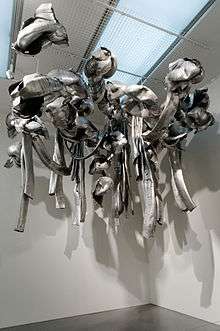Marisa Merz
| Marisa Merz | |
|---|---|
| Born |
1931 Turin, Italy |
| Nationality | Italian |
| Known for | Sculpting |
| Movement | Arte Povera |
| Awards | Biennale di Venezia Award for Lifetime Achievement |
Marisa Merz (born 1931) is an Italian sculptor, widow of artist Mario Merz. She now lives in Turin.
Life
Marisa Merz was born in Turin, Italy in 1931. In the 1950s she met Mario Merz who was studying there, and they later got married. They have a daughter, Beatriz (Bea) Merz.
Work

Marisa Merz was the only female to be accepted into the Arte Povera family. In 1967, for her first solo exhibition, Marisa made a folded aluminium foil installation. This exhibition was in June at the Gian Enzo Sperone gallery in Turin.[1] She was also one of the people involved in the Arte Povera + Azione Povera exhibition the following year at the Amalfi event. This show is the only Arte Povera exhibition that she participated in. Then in 1969 she had another solo show at the Attico Gallery in Rome.[2] Mario was supportive, evidently when he carried big rolled up blankets, created by Marisa in the Attico show. They had separate artistic lives, but were equally supportive of each other's work.[3] Although in the 1970s she didn't have exhibitions often, in 1970 she had a solo exhibition in Rome. This exhibition featured installations made by using knitted copper, under the title of Ad occhi chiusi gli occhi sono straordinariamente aperti ('To closed eyes, the eyes are extraordinarily open').
She was not an extensively recognized artist at the time, despite her huge contribution to the scene. The growth of feminism played a big role in her career, where society began to give her more consideration. Her work displays many of the fundamental issues with which Arte Povera artists are preoccupied, such as organic forms, focus on subjectivity, the use of lower forms of art, such as the crafts, and the relationship between art and life. Marisa's work has been described as lyrical, subtle, visionary and private.[4]
She often includes aspects of crafts and practices traditionally associated with women (e.g. knitting), and she often uses materials such as copper, aluminium, waxed paper and paraffin wax, which reflects her home environment, and "call[s] into question—if not subvert—the high-gloss finish of fine art and its deadness as an institutional commodity."[5] Her installations feature the idea of the home as a place intimate, private and feminine. An example is her 1966 installation, Untitled (Living Sculpture), which was intended both her home and to be presented in a gallery (she once said 'There has never been any division between my life and my work'). The installation consisted of thin strips of aluminium, clipped and suspended from the ceiling, forming coils and spirals. The work was acquired by Tate Modern in 2009.
In her 1975 artist statement she talks about the absent divide between her life and her work that she created. By this time she had extracted herself from the art scene and practically locked herself in her studio to work.[6] She reflects about life with her daughter, Bea, while she was constructing her aluminum sculptures, and how her daughter taught her so much in that time.[7]
At the Venice Biennale of 1988 she had site-specific installations involving amorphous and coloured wax heads.
Awards
In 2001, at the Venice Biennale, or Biennale di Venezia, Merz received the Special Jury Prize Award.
At the 2013 Venice Biennale she was awarded the Golden Lion for Lifetime Achievement (also called the Leone d'Oro).[8]
Recent Exhibitions[9]
- "The Shape of Time" at Walker Art Center, Minneapolis MI / 2005-2009
- "Italics, Italian Art between Tradition and Revolution, 1968-2008" at Palazzo Grassi, Francoi Pinault Foundation, Venice Italy / 2009-2010
- "Marisa Merz" at Gladstone Gallery, New York, New York / May - July 2010
- "Arte Povera" at Kunstmuseum Liechtenstein, Vaduz, Liechtenstein / 2010
- "Marisa Merz" at Gladstone Gallery, New York, New York / October - November 2010
- "Marisa Merz" at Gladstone Gallery, Brussels, Belgium / January - March 2011
- "Group Show" at Bernier Ellades, Athens, Greece / November 2011 - January 2012
- "Marisa Merz: Draw draw draw redraw the image thought that walks" at Foundation Merz, Turin, Italy / 2012
- "Marisa Merz" at Monica De Cardenas, Zuoz, St. Moritz, Switzerland / December 2012 - February 2013
- "Marisa Merz" at the Serpentine Gallery, London, UK / September 2013 - November 2013
References
- ↑ Lumley, Robert. "Movements in Modern Art, Arte Povera." London (2004): 34. Print.
- ↑ Lumley, Robert. "Movements in Modern Art, Arte Povera." London (2004): 34. Print.
- ↑ Lumley, Robert. "Movements in Modern Art, Arte Povera." London (2004): 37. Print.
- ↑ Schwarz, Dieter; Claire Gilman (Spring 2008). "The Irony of Marisa Merz". October. 124: 157–168. doi:10.1162/octo.2008.124.1.157. Retrieved 24 March 2013.
- ↑ Fisher, Cora (November 2011). "Marisa Merz". The Brooklyn Rail.
- ↑ Grenier, Catherine (1994). "Sur le nl du temps". Marisa Merz. Musee national d'Art moderne (Centre Georges Pompidou, Paris): 73–104; 261–78.
- ↑ Merz, Marisa (September–October 1975). Artist's Statements. Milan: compiled by Anne-Marie Sauzeau Boetti. pp. 50–55.
- ↑ http://www.artinamericamagazine.com/news-opinion/news/2013-05-06/venice-biennale-golden-lions-to-maria-lassnig-and-marisa-merz/
- ↑ "Events & Exhibits of Marisa Merz". Mutual Art.
External links
| Wikiquote has quotations related to: Marisa Merz |
- List of works
- List of exhibitions
- Tate Modern: Marisa Merz
- GroveArt: Marisa Merz
- ULAN Entries: Marisa Merz
- Sydney Biennale
- Tate Modern: Marisa Merz
- Recensione della mostra Marisa Merz. Non corrisponde eppur fiorisce (Venezia, 1 giugno - 18 settembre 2011)
- Marisa Merz: la dimensione ancestrale del costruire, sul portale RAI Arte
- Marisa Merz exhibition at the Serpentine Gallery